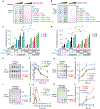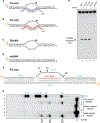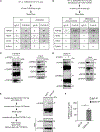Resolution of R-loops by topoisomerase III-β (TOP3B) in coordination with the DEAD-box helicase DDX5
- PMID: 35830799
- PMCID: PMC10575568
- DOI: 10.1016/j.celrep.2022.111067
Resolution of R-loops by topoisomerase III-β (TOP3B) in coordination with the DEAD-box helicase DDX5
Abstract
The present study demonstrates how TOP3B is involved in resolving R-loops. We observed elevated R-loops in TOP3B knockout cells (TOP3BKO), which are suppressed by TOP3B transfection. R-loop-inducing agents, the topoisomerase I inhibitor camptothecin, and the splicing inhibitor pladienolide-B also induce higher R-loops in TOP3BKO cells. Camptothecin- and pladienolide-B-induced R-loops are concurrent with the induction of TOP3B cleavage complexes (TOP3Bccs). RNA/DNA hybrid IP-western blotting show that TOP3B is physically associated with R-loops. Biochemical assays using recombinant TOP3B and oligonucleotides mimicking R-loops show that TOP3B cleaves the single-stranded DNA displaced by the R-loop RNA-DNA duplex. IP-mass spectrometry and IP-western experiments reveal that TOP3B interacts with the R-loop helicase DDX5 independently of TDRD3. Finally, we demonstrate that DDX5 and TOP3B are epistatic in resolving R-loops in a pathway parallel with senataxin. We propose a decatenation model for R-loop resolution by TOP3B-DDX5 protecting cells from R-loop-induced damage.
Keywords: CP: Molecular biology; DDX5; DNA-RNA hybrids; DNA/RNA topoisomerase 3B; R-loop; TDRD3; senataxin; topoisomerase cleavage complexes.
Copyright © 2022. Published by Elsevier Inc.
Conflict of interest statement
Declaration of interests The authors declare no competing interests.
Figures







Similar articles
-
TDRD3 promotes DHX9 chromatin recruitment and R-loop resolution.Nucleic Acids Res. 2021 Sep 7;49(15):8573-8591. doi: 10.1093/nar/gkab642. Nucleic Acids Res. 2021. PMID: 34329467 Free PMC article.
-
DNA and RNA Cleavage Complexes and Repair Pathway for TOP3B RNA- and DNA-Protein Crosslinks.Cell Rep. 2020 Dec 29;33(13):108569. doi: 10.1016/j.celrep.2020.108569. Cell Rep. 2020. PMID: 33378676 Free PMC article.
-
Thrap3 promotes R-loop resolution via interaction with methylated DDX5.Exp Mol Med. 2021 Oct;53(10):1602-1611. doi: 10.1038/s12276-021-00689-6. Epub 2021 Oct 25. Exp Mol Med. 2021. PMID: 34697388 Free PMC article.
-
Helicases in R-loop Formation and Resolution.J Biol Chem. 2023 Nov;299(11):105307. doi: 10.1016/j.jbc.2023.105307. Epub 2023 Sep 29. J Biol Chem. 2023. PMID: 37778731 Free PMC article. Review.
-
A genome-wide and cotranscriptional suppressor of R loops.Genes Dev. 2020 Jul 1;34(13-14):863-864. doi: 10.1101/gad.339861.120. Genes Dev. 2020. PMID: 32611612 Free PMC article. Review.
Cited by
-
SUGP1 loss is the sole driver of SF3B1 hotspot mutant missplicing in cancer.bioRxiv [Preprint]. 2025 Feb 17:2025.02.17.638713. doi: 10.1101/2025.02.17.638713. bioRxiv. 2025. Update in: Cell Rep. 2025 Aug 26;44(8):116075. doi: 10.1016/j.celrep.2025.116075. PMID: 40027711 Free PMC article. Updated. Preprint.
-
Structural insights into human topoisomerase 3β DNA and RNA catalysis and nucleic acid gate dynamics.Nat Commun. 2025 Jan 19;16(1):834. doi: 10.1038/s41467-025-55959-y. Nat Commun. 2025. PMID: 39828754 Free PMC article.
-
Maf-family bZIP transcription factor NRL interacts with RNA-binding proteins and R-loops in retinal photoreceptors.Elife. 2025 Mar 6;13:RP103259. doi: 10.7554/eLife.103259. Elife. 2025. PMID: 40047526 Free PMC article.
-
Association of DDX5/p68 protein with the upstream erythroid enhancer element (EHS1) of the gene encoding the KLF1 transcription factor.J Biol Chem. 2023 Dec;299(12):105489. doi: 10.1016/j.jbc.2023.105489. Epub 2023 Nov 22. J Biol Chem. 2023. PMID: 38000658 Free PMC article.
-
Tdrd3-null mice show post-transcriptional and behavioral impairments associated with neurogenesis and synaptic plasticity.Prog Neurobiol. 2024 Feb;233:102568. doi: 10.1016/j.pneurobio.2024.102568. Epub 2024 Jan 10. Prog Neurobiol. 2024. PMID: 38216113 Free PMC article.
References
Publication types
MeSH terms
Substances
Grants and funding
LinkOut - more resources
Full Text Sources
Miscellaneous

